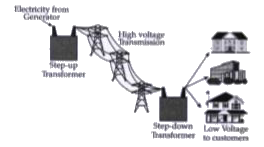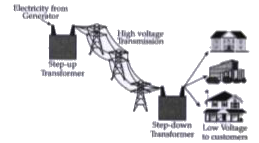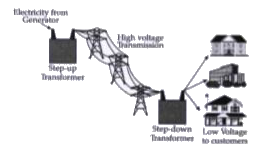Do the same exercise as above with the replacement of the earlier transformer by a 40,000-220 V step-down transformer (Neglect, as before, leakage losses though this may not be a good assumption any longer because of the very high voltage transmission involved). Hence, explain why high voltage transmission is preferred?
In this case, rms voltage at primary = 40,000 V primary current required
I = 80×1000W40,000V=20 A
(a) line power loss
P = I2R=20×20×15=6 Kw
The line power loss becomes 1/100 of that in previous case because line current becomes 1/10th times
(b) power supply by the plant = 800 + 6 = 806 kW
(C) voltage drop on the line
= IR = 20 ×15=300 V
The step-up transformer is 440 - 40,300
it clear from Q. 7.25 and 7.26 that percentage power loss is greatly reduced by high -voltage transmission.
In q. 7.25 , this power loss
Qutput powerInput power=61400×100=43 %
In q. 7.26 , this power loss
=Qutput powerInput power=6806×100=0.74 %
Topper's Solved these Questions
- ALTERNATING CURRENT BOOK - MODERN PUBLICATIONCHAPTER - ALTERNATING CURRENT EXERCISE - NCERT FILE EXEMPLAR PROBLEMS Subjective Question (VERY SHORT ANSWER TYPE QUESTIONS)
13 Videos
- ALTERNATING CURRENT BOOK - MODERN PUBLICATIONCHAPTER - ALTERNATING CURRENT EXERCISE - HIGHER ORDER THINKING SKILLS & ADVANCED LEVEL
7 Videos
- ALTERNATING CURRENT BOOK - MODERN PUBLICATIONCHAPTER - ALTERNATING CURRENT EXERCISE - NCERT FILE (TEXTBOOK EXERCISES )
11 Videos
- ATOMS BOOK - MODERN PUBLICATIONCHAPTER - ATOMS EXERCISE - Chapter Practice Test
16 Videos
Similar Questions
Do the same exercise as above with the replacement of the earlier transformer by a 40,000-220 V step-down transformer (Neglect, as before, leakage losses though this may not be a good assumption any longer because of the very high voltage transmission involved). Hence, explain why high voltage transmission is preferred?
View SolutionA village with a demand of 800 kW electric power at 220 V is located 30 km from an electric plant generating power at 440 V. The resistance of the two wire line carrying power is 0.25 Ω/km. The village gets power from the line through a 4000 V – 220 V step down transformer at a sub-station in the village. Assume negligible power loss in the transformers
(a) Estimate the power loss in form of heat in the transmission line.
(b) How much power must the plant supply?
(c) What is the input and output voltage of step-up transformer at the plant ?
(d) What difference will it make if the village receives power through a 40,000 V – 220 V step down transformer
View Solution
Knowledge Check
A generator at a utility company produces 100 A of current at 4000 V. The voltage is stepped up to 240000 V by a transformer before it is sent on a high voltage transmission line. The current in transmission line is
A3.67 AB2.67 AC1.67 AD2.40 AA generator at a utility company produces 100 A of current at 4000 V. The voltage is stepped up to 240000 V by a transformer before it is sent on a high voltage transmission line. The current in transmission line is
A3.67 AB2.67 AC1.67 AD2.40 AA generator at a utility company produces 100 A of current at 4000 V. The voltage is stepped up to 240000 V by a transformer before it is sent on a high voltage transmission line. The current in transmission line is
A3.67 AB2.67 AC1.67 AD2.40 A
Read the following text and answer the following questions on the basis of the same:
At power plant, a transformer increases the voltage of generated power by thousands of volts so that it can be sent of long distances through high-voltage transmission power lines. Transmission lines are bundles of wires that carry electric power from power plants to distant substations.
At substations, transformers lower the voltage of incoming power to make it acceptable for high volume delivery to nearby end-users.
Electricity is sent at extremely high voltage because it limits so-called line losses. Very good conductors of electricity also offer some resistance and this resistance becomes considerable over long distances causing considerable loss.

At generating station, normally voltage is stepped up to around thousands of volts. Power losses increase with the square of current. Therefore, keeping voltage high current becomes low and the loss is minimized.
Another option of minimizing loss is the use of wires of super-conducting material. Super-conducting materials are capable of conducting without resistance, they must be kept extremely cold, nearly absolute zero, and this requirement makes standard super-conducting materials impractical to use. However, recent advances in super-conducting materials have decreased cooling requirement. In Germany recently 1 km super-conducting cable have been installed connecting the generating station and the destination. It has eliminated the line loss and the cable is capable of sending five times more electricity than conventional cable. Using super-conducting cables Germany has also get rid of the need of costly transformers.
Transformers generate waste heat when they are in operation and oil is the coolant of choice. It transfers the heat through convection to the transformer housing, which has cooling fins or radiators similar to heat exchangers on the outside.
Flush point is a very important parameter of transformer oil. Flashpoint of an oil is the temperature at which the oil ignites spontaneously. This must be as high as possible (not less than 160∘C from the point of safety).
Fire point is the temperature at which the oil flashes and continuously burns. This must be very high for the chosen oil (not less than 200∘C).
Flush point of an oil is
View SolutionRead the following text and answer the following questions on the basis of the same:
At power plant, a transformer increases the voltage of generated power by thousands of volts so that it can be sent of long distances through high-voltage transmission power lines. Transmission lines are bundles of wires that carry electric power from power plants to distant substations.
At substations, transformers lower the voltage of incoming power to make it acceptable for high volume delivery to nearby end-users.
Electricity is sent at extremely high voltage because it limits so-called line losses. Very good conductors of electricity also offer some resistance and this resistance becomes considerable over long distances causing considerable loss.

At generating station, normally voltage is stepped up to around thousands of volts. Power losses increase with the square of current. Therefore, keeping voltage high current becomes low and the loss is minimized.
Another option of minimizing loss is the use of wires of super-conducting material. Super-conducting materials are capable of conducting without resistance, they must be kept extremely cold, nearly absolute zero, and this requirement makes standard super-conducting materials impractical to use. However, recent advances in super-conducting materials have decreased cooling requirement. In Germany recently 1 km super-conducting cable have been installed connecting the generating station and the destination. It has eliminated the line loss and the cable is capable of sending five times more electricity than conventional cable. Using super-conducting cables Germany has also get rid of the need of costly transformers.
Transformers generate waste heat when they are in operation and oil is the coolant of choice. It transfers the heat through convection to the transformer housing, which has cooling fins or radiators similar to heat exchangers on the outside.
Flush point is a very important parameter of transformer oil. Flashpoint of an oil is the temperature at which the oil ignites spontaneously. This must be as high as possible (not less than 160∘C from the point of safety).
Fire point is the temperature at which the oil flashes and continuously burns. This must be very high for the chosen oil (not less than 200∘C).
Why does stepping up voltages reduce power loss?
View SolutionRead the following text and answer the following questions on the basis of the same:
At power plant, a transformer increases the voltage of generated power by thousands of volts so that it can be sent of long distances through high-voltage transmission power lines. Transmission lines are bundles of wires that carry electric power from power plants to distant substations.
At substations, transformers lower the voltage of incoming power to make it acceptable for high volume delivery to nearby end-users.
Electricity is sent at extremely high voltage because it limits so-called line losses. Very good conductors of electricity also offer some resistance and this resistance becomes considerable over long distances causing considerable loss.

At generating station, normally voltage is stepped up to around thousands of volts. Power losses increase with the square of current. Therefore, keeping voltage high current becomes low and the loss is minimized.
Another option of minimizing loss is the use of wires of super-conducting material. Super-conducting materials are capable of conducting without resistance, they must be kept extremely cold, nearly absolute zero, and this requirement makes standard super-conducting materials impractical to use. However, recent advances in super-conducting materials have decreased cooling requirement. In Germany recently 1 km super-conducting cable have been installed connecting the generating station and the destination. It has eliminated the line loss and the cable is capable of sending five times more electricity than conventional cable. Using super-conducting cables Germany has also get rid of the need of costly transformers.
Transformers generate waste heat when they are in operation and oil is the coolant of choice. It transfers the heat through convection to the transformer housing, which has cooling fins or radiators similar to heat exchangers on the outside.
Flush point is a very important parameter of transformer oil. Flashpoint of an oil is the temperature at which the oil ignites spontaneously. This must be as high as possible (not less than 160∘C from the point of safety).
Fire point is the temperature at which the oil flashes and continuously burns. This must be very high for the chosen oil (not less than 200∘C).
Which of the following statement is true for long distance transmission of electricity?
View SolutionRead the following text and answer the following questions on the basis of the same:
At power plant, a transformer increases the voltage of generated power by thousands of volts so that it can be sent of long distances through high-voltage transmission power lines. Transmission lines are bundles of wires that carry electric power from power plants to distant substations.
At substations, transformers lower the voltage of incoming power to make it acceptable for high volume delivery to nearby end-users.
Electricity is sent at extremely high voltage because it limits so-called line losses. Very good conductors of electricity also offer some resistance and this resistance becomes considerable over long distances causing considerable loss.

At generating station, normally voltage is stepped up to around thousands of volts. Power losses increase with the square of current. Therefore, keeping voltage high current becomes low and the loss is minimized.
Another option of minimizing loss is the use of wires of super-conducting material. Super-conducting materials are capable of conducting without resistance, they must be kept extremely cold, nearly absolute zero, and this requirement makes standard super-conducting materials impractical to use. However, recent advances in super-conducting materials have decreased cooling requirement. In Germany recently 1 km super-conducting cable have been installed connecting the generating station and the destination. It has eliminated the line loss and the cable is capable of sending five times more electricity than conventional cable. Using super-conducting cables Germany has also get rid of the need of costly transformers.
Transformers generate waste heat when they are in operation and oil is the coolant of choice. It transfers the heat through convection to the transformer housing, which has cooling fins or radiators similar to heat exchangers on the outside.
Flush point is a very important parameter of transformer oil. Flashpoint of an oil is the temperature at which the oil ignites spontaneously. This must be as high as possible (not less than 160∘C from the point of safety).
Fire point is the temperature at which the oil flashes and continuously burns. This must be very high for the chosen oil (not less than 200∘C).
Super-conducting transmission line has the following advantages:
View SolutionRead the following text and answer the following questions on the basis of the same:
At power plant, a transformer increases the voltage of generated power by thousands of volts so that it can be sent of long distances through high-voltage transmission power lines. Transmission lines are bundles of wires that carry electric power from power plants to distant substations.
At substations, transformers lower the voltage of incoming power to make it acceptable for high volume delivery to nearby end-users.
Electricity is sent at extremely high voltage because it limits so-called line losses. Very good conductors of electricity also offer some resistance and this resistance becomes considerable over long distances causing considerable loss.

At generating station, normally voltage is stepped up to around thousands of volts. Power losses increase with the square of current. Therefore, keeping voltage high current becomes low and the loss is minimized.
Another option of minimizing loss is the use of wires of super-conducting material. Super-conducting materials are capable of conducting without resistance, they must be kept extremely cold, nearly absolute zero, and this requirement makes standard super-conducting materials impractical to use. However, recent advances in super-conducting materials have decreased cooling requirement. In Germany recently 1 km super-conducting cable have been installed connecting the generating station and the destination. It has eliminated the line loss and the cable is capable of sending five times more electricity than conventional cable. Using super-conducting cables Germany has also get rid of the need of costly transformers.
Transformers generate waste heat when they are in operation and oil is the coolant of choice. It transfers the heat through convection to the transformer housing, which has cooling fins or radiators similar to heat exchangers on the outside.
Flush point is a very important parameter of transformer oil. Flashpoint of an oil is the temperature at which the oil ignites spontaneously. This must be as high as possible (not less than 160∘C from the point of safety).
Fire point is the temperature at which the oil flashes and continuously burns. This must be very high for the chosen oil (not less than 200∘C).
Oil transfers heat from transformer winding by the process of:
View Solution
